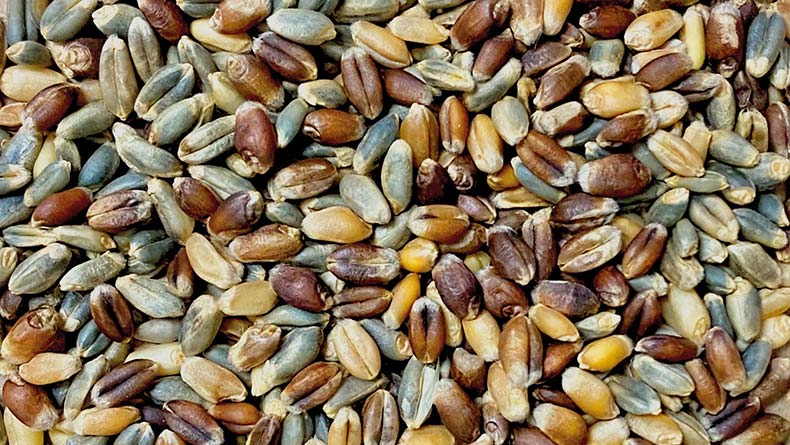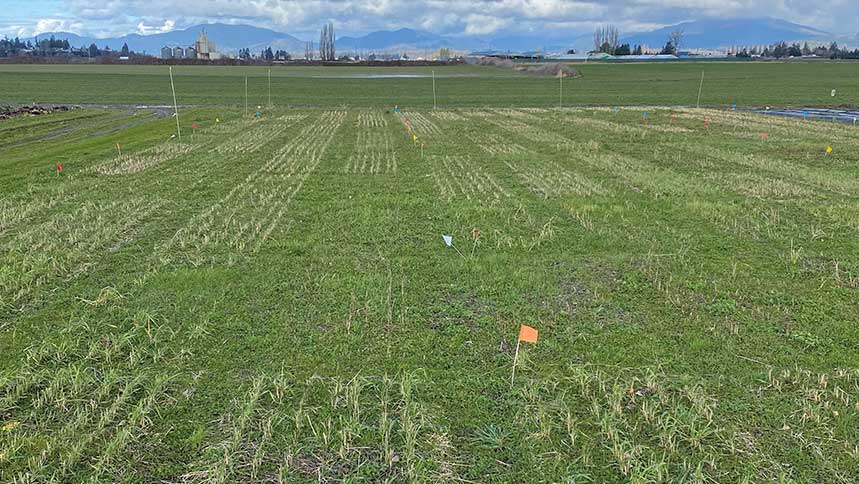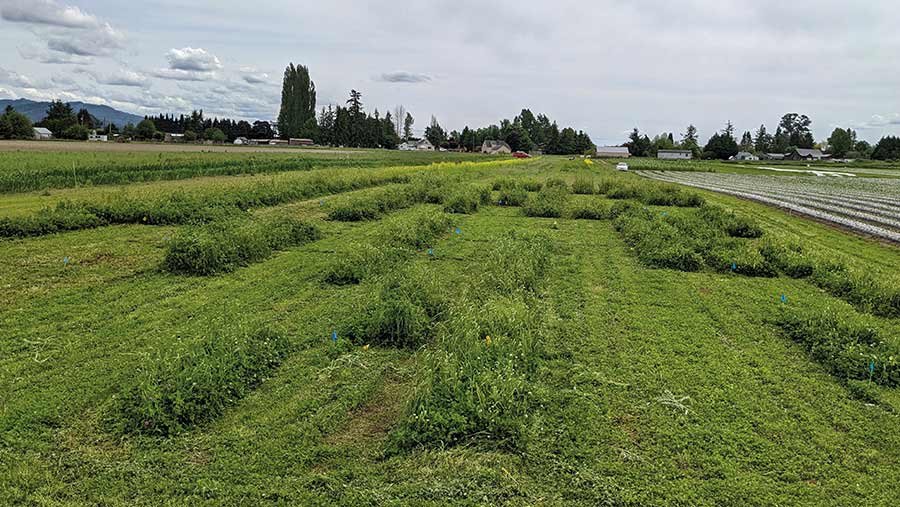Are perennial grain crops close to being a realistic alternative?
 Seeds from Breadlab’s Climate Blend population showing diversity and colour differences © Breadlab
Seeds from Breadlab’s Climate Blend population showing diversity and colour differences © Breadlab Perennial grain crops –those you only plant once before harvesting multiple times – would potentially deliver many favourable on-farm attributes – not least savings in seed and fuel costs, reduced cultivations and lower input requirements.
Research has also shown increased carbon sequestration, improved soil structure, reduced soil erosion risk and better nutrient use efficiency.
In addition, they will adhere to many of the key regenerative agriculture principles, including no soil disturbance, a permanent living root in the soil and 100% ground cover. Some perennial crops could be grazed as well as producing grain.
See also: How Yorkshire grower reduced risk with regenerative system
But while progress is being made by researchers to create perennial grain crops, with rice, wheat and near-wheat relatives already commercialised or close to it, there remains significant barriers before they become widespread – not least extremely low yields in some cases.
Creating a perennial grain crop is far from easy. There are two main methods: either domesticating a perennial species that has desirable characteristics, such as consistently high seed yields, synchronous flowering and seed maturation, or crossing an existing annual grain crop with a wild perennial cousin.
The aim of these hybrid crosses is to produce plants that maintain seed yield and quality of the annual parent while inheriting the perennial lifestyle of the other parent.
The Land Institute, based in Salina, Kansas, has been using both methods to develop perennial grains, pulses and oilseeds since 1976.
The biggest success, so far, has been with perennial rice, developed in conjunction with the University of Yunnan, says Lennart Olsson, a board member at the Land Institute and geography professor at Lund University in Sweden.
Yields from perennial rice grown by 11,000 smallholder farmers in 10 countries have been similar to annual crops, but net profits almost doubled because of lower labour and input requirements, he says.
There has been much greater controversy around the Land Institute’s other commercialised perennial grain, Kernza.
Bred by domesticating intermediate wheat grass, a relative of wheat, trials have suggested yields of about 1t/ha in year one from the grain, which can be used to make beer, breakfast cereals and cakes.
But in years two and three, yields decline, typically by at least 50%, and even up to 84% in one study, probably due to competition effects.
One promising study found strip-tilling in the autumn after year three improved yields in year four.
Prof Olsson says the latest research suggests Kernza yields are improving by up to 9% per breeding cycle, which are now only taking six months compared with the five years in the past, thanks to using genomic assisted-breeding techniques.
“Nine percent is a phenomenal rate of increase and there is a good chance that Kernza will have yields on par [in Kansas] with wheat in less than 20 years,” he claims.

The second year organic perennial field breeding lines © Breadlab
Kernza
Kernza can be planted in either autumn or spring using conventional drilling equipment, but it won’t head until year two if planted in the spring, as it needs six weeks of temperatures between 0C and 10C to vernalise and produce grain.
One of its key characteristics is huge root growth – up to 15 times the root mass after four years of annual grain crops.
Inputs are low – in the US a 2,4-D amine broad-leaf herbicide has been approved, although its competitiveness should reduce weed competition.
About 65-90kg/ha of nitrogen fertiliser has been found to be optimum, although higher rates might be possible on newer varieties of Kernza, which are shorter and less prone to lodging, helping to increase yields.
Nitrogen uptake is up to 95%, Prof Olsson suggests.
The crop can also potentially be grazed over winter to provide another source of income for growers. This might also increase carbon sequestration, researchers suggest.
Washington State University’s Breadlab is developing short-lived perennial wheat, as well as speciality non-commodity coloured wheat grains, using what founder Stephen Jones calls the technique of “making domestic wheat more wild”.
While Dr Jones started Breadlab after becoming disillusioned by commoditised white flour 10 years ago, his interest in perennial wheat began in 1995.
“Our strategy is to take intermediate wheat grass and cross it into wheat, and then develop lines that will regrow. For us, two to three years’ regrowth is plenty.”
That’s no easy feat and can cause inefficiencies in breeding if not many lines regrow, or, perversely, if they continue growing without going dormant, as that leaves the plant in danger of heading too early and being susceptible to winter weather.
Grazing is one potential solution to reduce this risk and force dormancy, Dr Jones suggests.
There is much research still to be done, he says, but in the latest breeding trials, 80 lines from 182 initial plots had headed in year two from an October 2020 planting. These lines will go into more advanced trials this autumn.
Perennial cereals
- Many benefits, including reduced costs
- Help to reduce carbon emissions
- Barriers remain with yields
- Impressive genetic gain with Kernza
- Breadlab looking at mixes, which are showing good promise
Hulled grain
Another challenge is finding varieties that will thresh well – Kernza is not free-threshing as it is a hulled grain. “We want hull-less, large wheat-like grains that yield well,” Dr Jones says.
Perennials tend to head and mature later than annuals – typically two to three weeks – although hot, dry weather can bring harvest forward, and not always all at the same time.
“That can be tough to overcome, particularly if, like us, you’re inter-seeding annuals into the population.”
Breadlab’s aim is to produce populations of different perennial wheat varieties, rather than the traditional monoculture variety.
This increases diversity in the field and resilience to climate and other environmental stresses, Dr Jones explains.
“Our most advanced population has 20 perennial lines.”
In the first year of growth it can yield 5t/ha – significantly more than Kernza. Second-year yields are at best 50% of that in farmers’ fields. “That’s why we add the annuals in, as well as to increase the diversity.”

Second year regrowth of organic large-seeded perennial breeding nursery with a clover undergrowth © WSU/Breadlab
It was that kind of yield promise that attracted North Dakotan regenerative farmer Gabe Brown to Breadlab’s perennial wheats.
“It’s slightly less yield than our current wheats,” says Mr Brown, who is growing 10ha on his farm this season.
“But our costs will be much less and there will be a much higher premium for higher-quality grain. Plus you’ll be able to graze livestock in the off-season, so there are a lot of benefits. I think it has potential to be a win-win.”
His regenerative agriculture consultancy firm, Understanding Ag, has been hired by Breadlab Grains, a company that has been set up to commercialise perennial wheat from Breadlab, to help select regenerative farms to breed seed ahead of commercialisation.
“There are about 100ha being grown for seed production in total this year,” Mr Brown says.
Once commercialised, the plan will be to connect farmers directly with millers and bakers, says Dr Jones. “We want a market for it upfront initially, with baking groups selling flour as a climate blend.”
The 100% wholemeal flour can be used without any additives in pastry and to make square tin breads. Blending with other heritage grain flours can open more uses.
Future
So what does the future hold for perennial crops? Prof Olsson is optimistic about a perennial revolution. “Business as usual is not an option,” he suggests. “It is clear agriculture needs to change.”
There is clear scientific backing for perennial crops, he claims, but recognises it would be the first time agriculture has changed in favour of ecological systems, compared with virtually all previous major developments, such as ploughing, Haber-Bosch and genetically modified cropping.
“I also haven’t met a farmer not in favour of perennials. When they yield sufficiently, it will drastically reduce the management and cost of inputs.”
He hopes for a future where the perennial legume sainfoin, Kernza and alfalfa can be grown and harvested together.
Dr Jones is more circumspect. “I’m under no illusion that perennial wheat will replace 40m acres of wheat in the US,” he says.
“We look at perennial grains as part of a whole system, not a standalone. We’re not feeding or saving the world with these, but we’re convinced diversity is key, and while the big players in ag can’t handle diversity at the moment, I think they are going to have to,” he concludes.
European work
Since 2020, a group of 25 farmers in France have been trialling Kernza with a research team from Isara, the Rhône-Alpes Higher Institute of Agriculture.
Early experience found establishment was challenging, especially with early weed control.
Harvest results from the first year showed a biomass yield range of 2-10t/ha of dry matter and grain at 100-1,500kg/ha.
Further work is planned to look at plant densities and cropping practices to optimise grain production in the first year of establishment, as well as the following years.

